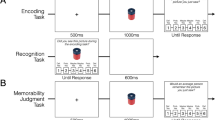Abstract
Human perception thresholds can improve through learning. Here we report findings challenging the fundamental 'practice makes perfect' basis of procedural learning theory, showing that brief reactivations of encoded visual memories are sufficient to improve perceptual discrimination thresholds. Learning was comparable to standard practice-induced learning and was not due to short training per se, nor to an epiphenomenon of primed retrieval enhancement. The results demonstrate that basic perceptual functions can be substantially improved by memory reactivation, supporting a new account of perceptual learning dynamics.



Similar content being viewed by others
References
Karni, A. & Sagi, D. Nature 365, 250–252 (1993).
Censor, N., Sagi, D. & Cohen, L.G. Nat. Rev. Neurosci. 13, 658–664 (2012).
Zhou, X. & Merzenich, M.M. Proc. Natl. Acad. Sci. USA 104, 15935–15940 (2007).
Jones, S.V., Choi, D.C., Davis, M. & Ressler, K.J. J. Neurosci. 28, 13106–13111 (2008).
Nader, K., Schafe, G.E. & Le Doux, J.E. Nature 406, 722–726 (2000).
Dudai, Y. Annu. Rev. Neurosci. 35, 227–247 (2012).
Schiller, D. et al. Nature 463, 49–53 (2010).
de Beukelaar, T.T., Woolley, D.G. & Wenderoth, N. Cortex 59, 138–145 (2014).
Censor, N., Horovitz, S.G. & Cohen, L.G. Neuron 81, 69–76 (2014).
Rouder, J.N., Morey, R.D., Speckman, P.L. & Province, J.M. J. Math. Psychol. 56, 356–374 (2012).
Morey, R.D. & Rouder, J.N. BayesFactor 0.9. 12–2. https://cran.r-project.org/web/packages/BayesFactor/index.html (Comprehensive R Archive Network, 2015).
Johnson, V.E. Proc. Natl. Acad. Sci. USA 110, 19313–19317 (2013).
Lee, J.L. Nat. Neurosci. 11, 1264–1266 (2008).
Censor, N., Karni, A. & Sagi, D. Vision Res. 46, 4071–4074 (2006).
Aberg, K.C., Tartaglia, E.M. & Herzog, M.H. Vision Res. 49, 2087–2094 (2009).
Hussain, Z., Sekuler, A.B. & Bennett, P.J. Vision Res. 49, 2624–2634 (2009).
Ahissar, M. & Hochstein, S. Nature 387, 401–406 (1997).
Tartaglia, E.M., Bamert, L., Mast, F.W. & Herzog, M.H. Curr. Biol. 19, 2081–2085 (2009).
Menzel, R., Manz, G., Menzel, R. & Greggers, U. Learn. Mem. 8, 198–208 (2001).
Stickgold, R., James, L. & Hobson, J.A. Nat. Neurosci. 3, 1237–1238 (2000).
Acknowledgements
We thank J. Herszage, H. Harris, and D. Sagi for their feedback on this work and Y. Bonneh for experimental programming. The study was supported by the I-CORE program of the Planning and Budgeting Committee and the ISF (grant 51/11).
Author information
Authors and Affiliations
Contributions
R.A.H., R.L.M., S.N., and N.C. designed the experiments. R.A.H., R.L.M., S.N., and N.C. collected the data. R.A.H., R.L.M., S.N., J.D.R., and N.C. analyzed the data. R.A.H., R.L.M., J.D.R., and N.C. wrote the paper.
Corresponding author
Ethics declarations
Competing interests
The authors declare no competing financial interests.
Supplementary information
Rights and permissions
About this article
Cite this article
Amar-Halpert, R., Laor-Maayany, R., Nemni, S. et al. Memory reactivation improves visual perception. Nat Neurosci 20, 1325–1328 (2017). https://doi.org/10.1038/nn.4629
Received:
Accepted:
Published:
Issue Date:
DOI: https://doi.org/10.1038/nn.4629
- Springer Nature America, Inc.
This article is cited by
-
The phase of plasticity-induced neurochemical changes of high-frequency repetitive transcranial magnetic stimulation are different from visual perceptual learning
Scientific Reports (2023)
-
Reactivation-induced motor skill modulation does not operate at a rapid micro-timescale level
Scientific Reports (2023)
-
Brief memory reactivations induce learning in the numeric domain
npj Science of Learning (2022)
-
Mechanisms of offline motor learning at a microscale of seconds in large-scale crowdsourced data
npj Science of Learning (2020)
-
Interlimb transfer and generalisation of learning in the context of persistent failure to accomplish a visuomotor task
Experimental Brain Research (2019)





